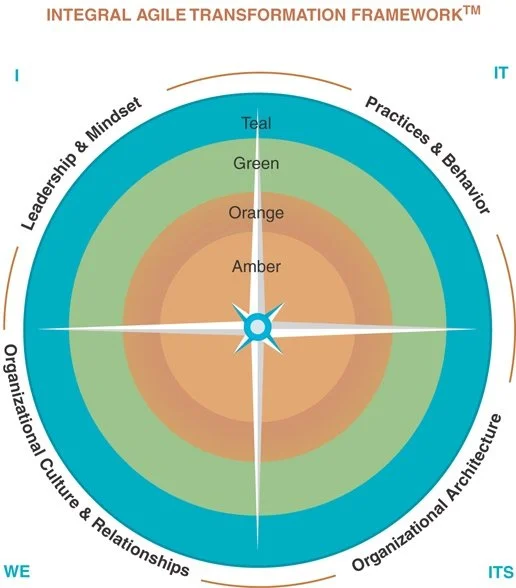Simple Rules, Big Impact
Catalyzing Your Organization from Amber to Teal
By William Guevara
In today's increasingly complex and unpredictable organizational world, simple rules emerge as a powerful tool to catalyze organizational change. Simple rules, often influenced by limiting beliefs, dictate cultural patterns typical of Amber and Orange altitudes according to the Integral Theory.
These rules can be redesigned through a conscious and strategic approach to promote cultural evolution towards higher altitudes, such as Green and Teal, where collaboration, self-management, and adaptability become the norm. The edition provides a practical framework for identifying, challenging, and transforming Simple Rules, offering concrete examples and clear steps to implement sustainable cultural change in organizations of any size or sector.
Agile Transformation Using Integral Approach
Agile Transformation: Using the Integral Agile Transformation Framework to Think and Lead Differently, by Michael K. Spayd and Michele Madore.
What?
Simple Rules: The DNA of Organizational Culture
In every organization, a set of Simple Rules guides behaviors, decisions, and cultural patterns, consciously or unconsciously. These rules are not formal manuals or processes but tacit or explicit principles dictating day-to-day actions. They function as the cultural DNA, influencing everything from team dynamics to organizational strategies.
However, these Simple Rules do not emerge in a vacuum. They are deeply influenced by collective beliefs, which can be represented by the “dragons” described in The Dragons of Complexity (see my previous blog post). These dragons act as cognitive filters, shaping the current simple rules and, consequently, the predominant cultural patterns.
Dragons That Inform Current Rules at Amber and Orange Altitudes
Dragon 1: Certainty is an Illusion
Current Organization Rule: "Always follow the established process, avoid deviations."
Amber Pattern: Strong orientation towards control and hierarchy; low adaptability.
Dragon 2: Patterns and Problems
Current Rule: "If something repeats, it is a problem to be solved immediately."
Orange Pattern: Continuous pursuit of operational efficiency, often overreacting to emerging patterns.
Dragon 3: Differences Are Not a Problem
Current Rule: "Consensus is key, avoid confrontations."
Amber Pattern: Prioritizes superficial harmony over diversity of thought.
Dragon 4: Time Is Not a Line
Current Rule: "Plan everything in detail before starting."
Orange Pattern: Predominance of linear and predictive planning, with little flexibility for adjustments.
Dragon 5: Precision or Accuracy
Current Rule: "The important thing is that everything is perfect before launching."
Orange Pattern: Focus on technical precision, often at the expense of speed and adaptability.
How Do These Rules Dictate the Organization's Current Pattern?
The impact of these Simple Rules influenced by dragons translates into specific cultural patterns of Amber and Orange altitudes:
Rules in an Amber Organization:
Obedience to hierarchy and process prevails.
Decisions are centralized, valuing stability over innovation.
Uniformity is favored, avoiding cognitive dissonance.
Rules in an Orange Organization:
Efficiency and continuous optimization are sought.
Focus on measurable results and achieving goals, sometimes at the expense of team cohesion.
Adaptability is secondary to perfection and predictability.
These Simple Rules dictate the organization's current pattern, creating an environment where underlying beliefs and assumptions limit agility and innovation. Without conscious intervention, these rules will continue to reinforce Amber/Orange patterns, preventing the transition to more evolved altitudes like Green and Teal.
So What?
How Simple Rules Can Catalyze Organizational Change
Simple Rules not only reflect an organization's current state but also have the power to transform it. By becoming aware of the dragons that inform them, it is possible to redesign these rules intentionally, aligning them with an organizational change that elevates the cultural altitude towards Green and Teal.
Process to Modify Simple Rules: From Inertia to Intention
Identify Current Rules
Current rules reveal underlying beliefs (the dragons) and the predominant cultural altitude:
Current Rule: "Always follow the established process, avoid deviations."
Dragon: Certainty is an Illusion
Altitude: Amber (Control and hierarchy)
Become Aware of the Underlying “Dragon”
Limiting Belief: The quest for absolute certainty leads to excessive control and low adaptability.
Cultural Impact: Foster obedience instead of autonomy. Prioritizes stability over innovation.
Redesign Simple Rules with Intention
The goal is to move the organization from Amber/Orange to Green/Teal:
From: "Always follow the established process, avoid deviations."
To: "Explore new ways of doing things, learn from the process."
Cultural Evolution: From Amber (control) to Green (collaboration and learning).
How Can These New Rules Impact Green and Teal Altitudes?
Rules In a Green Organization:
Diversity of perspectives is valued, and genuine collaboration is encouraged.
Decision-making is more inclusive, prioritizing collective well-being.
New ideas are experimented with without fear of failure.
Rules In a Teal Organization:
Self-management and distributed decision-making prevail.
The organization is perceived as a living system constantly adapting.
Rules are flexible guides, not rigid constraints, allowing continuous evolution.
Now What?
Concrete Actions to Implement New Simple Rules
Practice the New Rule in Daily Activities
During team meetings, ask: "Has anyone tried a different approach? What did we learn?"
Create Rituals and Reflection Spaces
Intentional Retrospectives: Evaluate not only what worked but also how the new rules impacted results and culture.
Measure Progress Towards New Cultural Altitudes
Qualitative Indicators: Does the team feel safer experimenting? Are learnings celebrated, even when results are not perfect?
Quantitative Indicators: Number of experiments conducted. Adaptation speed to external changes.
Reinforce New Rules with Stories and Examples
Storytelling: Share real examples of how following new rules led to positive outcomes.
Maintain Adaptability
Periodically review Simple Rules.
Adapt them according to the context and emerging needs.
Simple Rules are Catalysts for Organizational Change
Simple Rules have the power to transform organizational culture, especially when intentionally redesigned. Identifying how the Dragons influence current rules makes it possible to create a conscious path toward higher cultural altitudes. This enhances the organization's ability to navigate complexity and allows healthier, more agile patterns to flourish, aligned with the principles of Green and Teal.
William Guevara is a Thought Leader specializing in Enterprise Coaching. With extensive experience in integral coaching and change management, he is dedicated to helping organizations thrive in the digital era. Holding multiple certifications—including Human Systems Dynamics Professional (HSDP)—William leverages his credentials to design and deliver impactful interventions that enhance the performance and potential of leaders, teams, and systems.
His work is not just a profession but a passion, combining coaching, complexity science, integral theory, and systems thinking to tackle today’s challenges and opportunities. His mission is to serve as a catalyst for a holistic life purpose that benefits others. William lives and works in Madrid, Spain.




